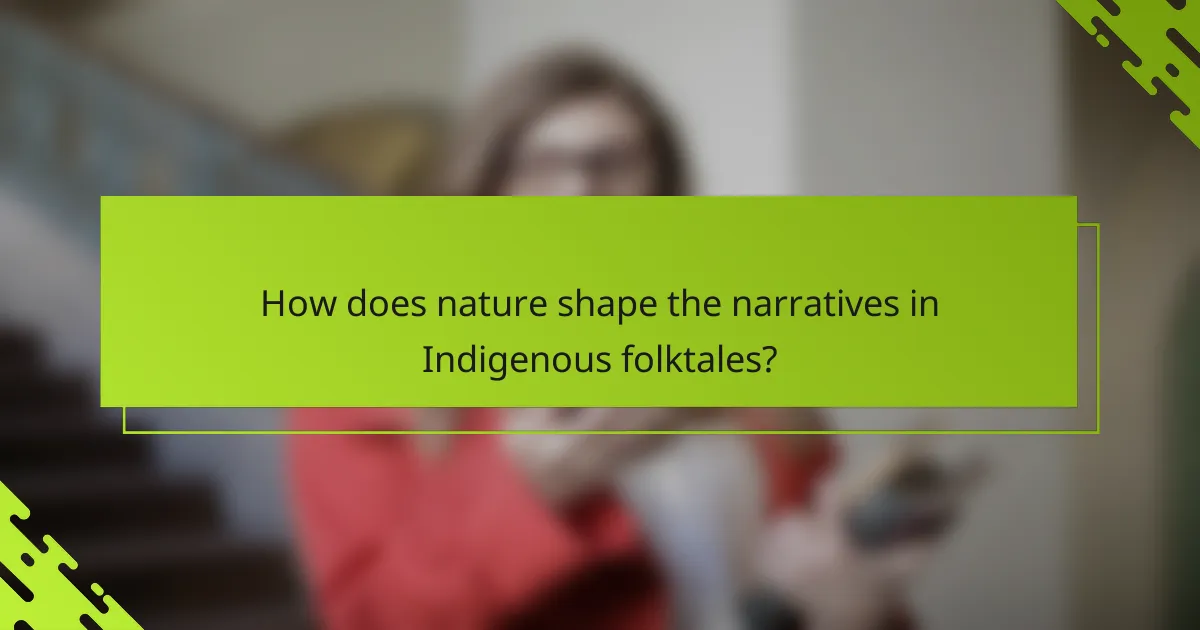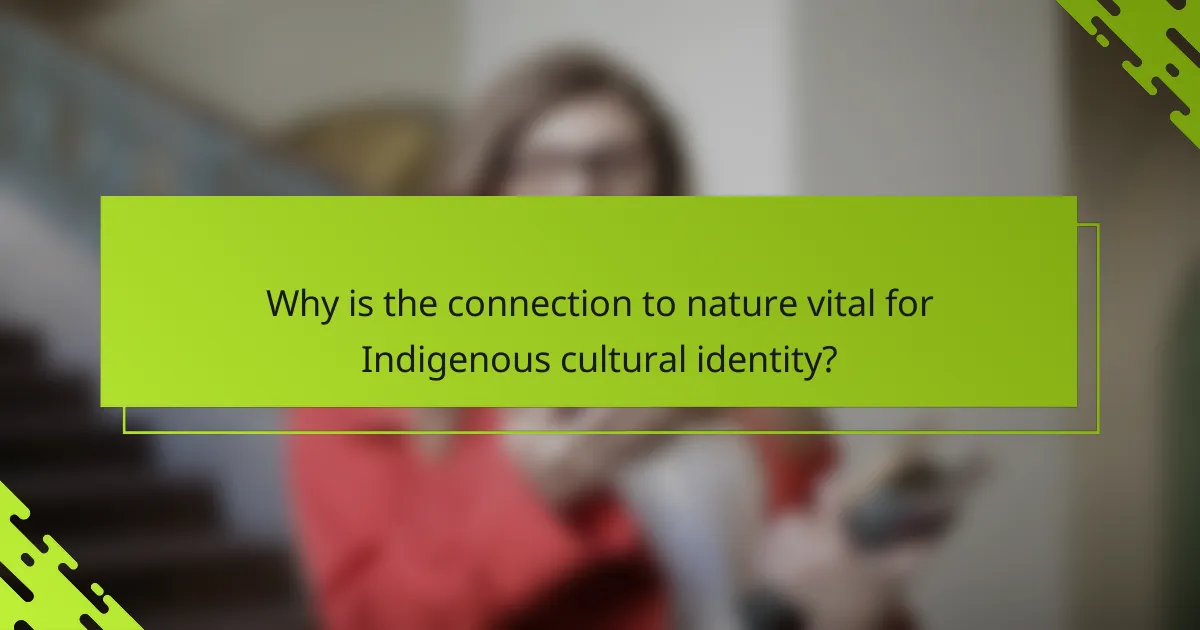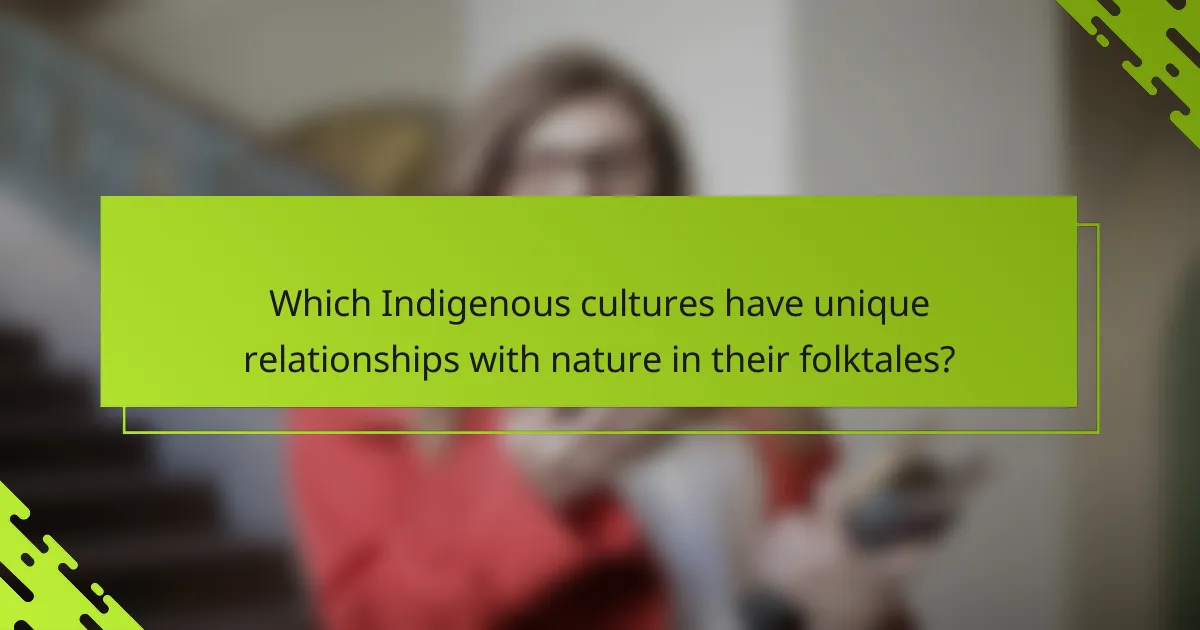Indigenous folktales play a crucial role in shaping cultural identity and community values. These narratives illustrate the deep connection between people and nature, emphasizing respect and sustainability. They highlight unique relationships with the environment across various cultures and adapt to modern challenges while preserving core values. Engaging with these stories enhances environmental awareness and promotes stewardship of natural resources.

How does nature shape the narratives in Indigenous folktales?
Nature profoundly influences Indigenous folktales, shaping cultural identity and community values. The landscapes, flora, and fauna depicted in these stories reflect the relationship between people and their environment. This connection fosters a deep sense of belonging and respect for nature. For example, many tales illustrate moral lessons derived from natural elements, reinforcing the importance of harmony with the ecosystem. Such narratives often serve as a guide for sustainable living, emphasizing the unique attributes of specific regions and their resources. By intertwining nature with identity, Indigenous folktales preserve cultural heritage and promote environmental stewardship.
What themes of nature are prevalent in Indigenous storytelling?
Nature plays a vital role in Indigenous storytelling, reflecting cultural identity and values. Themes such as interconnectedness, respect for the environment, and the spiritual significance of animals and plants are prevalent. These narratives emphasize the relationship between people and nature, showcasing how the land shapes cultural practices and beliefs. Unique attributes include the portrayal of nature as a living entity, highlighting its influence on community identity and moral lessons. Rarely, specific natural events or phenomena serve as pivotal plot points, illustrating deeper connections to ancestral heritage.
How do natural elements symbolize cultural beliefs?
Natural elements symbolize cultural beliefs by embodying values, morals, and teachings in Indigenous folktales. For instance, animals often represent traits such as wisdom or bravery, while plants may signify healing or nourishment. These symbols foster cultural identity and continuity, linking generations through shared narratives. Nature’s role in these stories reinforces the connection between people and their environment, reflecting a deep respect for the land and its resources.

Why is the connection to nature vital for Indigenous cultural identity?
The connection to nature is vital for Indigenous cultural identity as it shapes beliefs, traditions, and practices. Nature provides a source of spiritual guidance and cultural narratives that reinforce community values. Indigenous folktales often highlight the relationship between people and the natural world, illustrating lessons about respect, sustainability, and interconnectedness. This bond fosters a sense of belonging and identity, rooted in the land and its resources. As a result, the preservation of natural environments becomes essential for maintaining cultural heritage and practices.
How does nature influence community values and traditions?
Nature significantly shapes community values and traditions, especially in Indigenous cultures. The natural environment influences storytelling, rituals, and social norms. For instance, Indigenous folktales often reflect the relationship with land and animals, emphasizing respect and harmony. These narratives reinforce cultural identity and collective memory, passing down values across generations. As a result, nature serves as a fundamental source of inspiration and guidance, defining community beliefs and practices.
What role does nature play in spiritual practices?
Nature plays a crucial role in spiritual practices by serving as a source of inspiration and connection. Indigenous folktales often illustrate this bond, emphasizing the relationship between the land and cultural identity. The natural world is viewed as sacred, influencing rituals and beliefs. For example, many tribes incorporate elements like rivers, mountains, and animals into their spiritual narratives, reinforcing their cultural heritage. This connection fosters a sense of belonging and continuity, essential for maintaining cultural identity.

Which Indigenous cultures have unique relationships with nature in their folktales?
Many Indigenous cultures have unique relationships with nature reflected in their folktales. These stories often emphasize harmony, respect, and interconnectedness with the natural world.
For example, the Navajo culture features tales of the Earth and sky, illustrating the importance of balance. In contrast, the Inuit share stories that highlight survival in harsh climates, showcasing their deep understanding of the environment.
Unique attributes of these folktales include the use of animals as spiritual guides and the incorporation of natural elements as characters. This reflects a rare attribute of Indigenous storytelling, where nature is not merely a backdrop but an integral part of the narrative.
These relationships foster cultural identity and teach values, emphasizing the role of nature in sustaining life and community.
How do the stories of the Ojibwe reflect their natural environment?
The stories of the Ojibwe deeply reflect their natural environment by intertwining elements of nature with cultural identity. These narratives illustrate the significance of land, water, and wildlife, showcasing their interconnectedness with the Ojibwe way of life. Nature serves as a backdrop for moral lessons, spiritual beliefs, and communal values. For example, the teachings about the migratory patterns of animals emphasize respect for the ecosystem. This relationship with nature fosters a unique attribute of resilience and adaptation within Ojibwe culture, as they draw inspiration from their surroundings to navigate challenges.
What distinctive traits are found in the Inuit’s connection to nature?
The Inuit’s connection to nature is characterized by deep respect, reliance on traditional knowledge, and spiritual significance. They view the environment as a living entity, influencing their cultural identity and folktales. This relationship fosters sustainability and emphasizes harmony with wildlife. Unique traits include a profound understanding of seasonal changes and animal behavior, which guide their subsistence practices. Rarely, Inuit stories reflect themes of reciprocity and balance, illustrating their interconnectedness with the land and its resources.

What are the impacts of modernity on Indigenous narratives about nature?
Modernity significantly alters Indigenous narratives about nature by introducing external perspectives and challenges. These narratives traditionally emphasize a deep connection to the land, which modern influences can disrupt.
As Indigenous communities encounter globalization, their stories may adapt to incorporate contemporary themes. For instance, climate change now features prominently, reflecting urgent environmental concerns. This shift highlights the unique attribute of resilience, as these narratives evolve while maintaining cultural identity.
Furthermore, modernity can lead to a rare attribute: the blending of traditional ecological knowledge with scientific understanding. This fusion enriches the narratives, offering new insights into sustainable practices.
Ultimately, modernity impacts Indigenous narratives by reshaping their content and context, while still striving to preserve core cultural values.
How are traditional stories adapting to contemporary environmental issues?
Traditional stories are increasingly addressing contemporary environmental issues by integrating themes of sustainability and respect for nature. Indigenous folktales often reflect a deep connection to the land, emphasizing the importance of ecological balance.
These narratives adapt to modern contexts by showcasing the consequences of environmental neglect. For instance, stories may illustrate the impact of pollution on wildlife, urging communities to take action. This adaptation reinforces cultural identity while promoting environmental stewardship.
Additionally, many Indigenous cultures are revitalizing traditional storytelling methods to engage younger generations in discussions about climate change. By weaving contemporary issues into age-old tales, they foster a sense of responsibility towards nature.
Ultimately, the evolution of these stories highlights the enduring relevance of cultural narratives in addressing urgent global challenges.
What challenges do Indigenous storytellers face in preserving natural narratives?
Indigenous storytellers face significant challenges in preserving natural narratives. These include cultural appropriation, loss of language, and environmental degradation. Cultural appropriation often distorts traditional stories, leading to misrepresentation. The decline of Indigenous languages limits the transmission of narratives, making it difficult to convey cultural meanings. Environmental degradation threatens the very landscapes that inspire these stories, diminishing their relevance. Additionally, modern technology and media can overshadow traditional storytelling methods, complicating preservation efforts. These challenges collectively jeopardize the integrity of Indigenous folktales and their connection to cultural identity.

How can understanding Indigenous folktales enhance environmental awareness?
Understanding Indigenous folktales enhances environmental awareness by illustrating the deep connection between nature and cultural identity. These stories often emphasize respect for the land and its resources, promoting sustainable practices. For example, many folktales feature animals as central characters, teaching lessons about coexistence and environmental stewardship. This narrative tradition fosters a sense of responsibility towards nature, encouraging communities to protect their ecosystems. By engaging with these stories, individuals can gain insights into traditional ecological knowledge and the importance of preserving biodiversity.
What lessons from Indigenous stories can inform current conservation efforts?
Indigenous stories emphasize interconnectedness with nature, offering lessons for contemporary conservation. These narratives highlight sustainable practices, respect for ecosystems, and the importance of biodiversity. For instance, many Indigenous cultures view land as a living entity, fostering stewardship rather than exploitation. This perspective can inform current conservation strategies by promoting holistic approaches that prioritize ecological balance. Additionally, the oral traditions of Indigenous peoples preserve valuable knowledge about local species and habitats, which can enhance scientific understanding and inform policy decisions.
How can these narratives foster respect for biodiversity?
Indigenous folktales promote respect for biodiversity by embedding ecological wisdom and cultural values within narratives. These stories often illustrate the interconnectedness of all life forms, emphasizing sustainable practices and the importance of preserving natural habitats. For example, many tales highlight the consequences of environmental neglect, fostering a sense of responsibility towards nature. By passing down these narratives, communities reinforce their cultural identity while advocating for the protection of biodiversity. This approach not only nurtures respect for nature but also strengthens the bond between cultural heritage and environmental stewardship.
What best practices can be adopted for integrating Indigenous wisdom into environmental education?
Integrating Indigenous wisdom into environmental education involves respecting cultural narratives and practices. Incorporate local Indigenous stories that emphasize the relationship between nature and identity. Engage Indigenous elders as educators to share knowledge directly. Use experiential learning methods that connect students to the land, fostering a sense of stewardship. Encourage collaborative projects that involve Indigenous communities, ensuring their voices shape the curriculum. Recognize the unique attributes of Indigenous ecological knowledge, which can offer sustainable solutions for contemporary environmental challenges.
